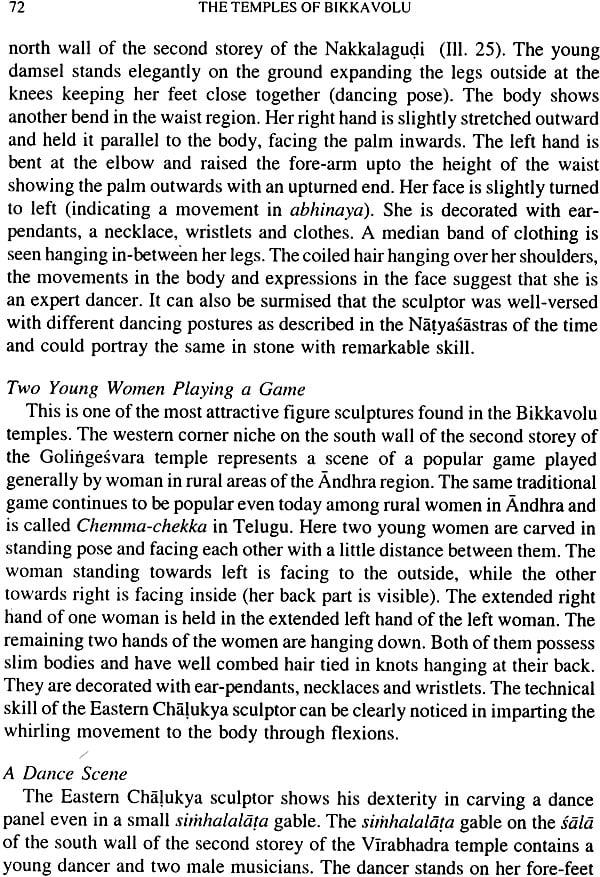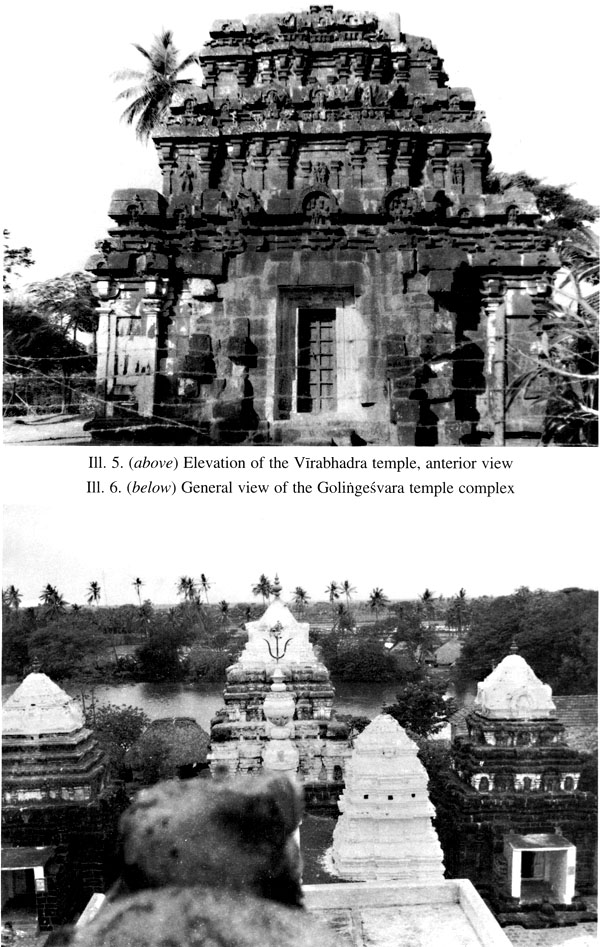
The Temples of Bikkavolu
Book Specification
| Item Code: | IDE103 |
| Author: | S. Nageswara Rao |
| Publisher: | Munshiram Manoharlal Publishers Pvt. Ltd. |
| Language: | English |
| Edition: | 2005 |
| ISBN: | 8121510295 |
| Pages: | 157 (B & W Illus: 58, Figures: 5) |
| Cover: | Hardcover |
| Other Details | 9.8" X 7.4" |
| Weight | 670 gm |
Book Description
This book is a pioneering study on the contribution of Eastern Chalukyas to the art and architecture of Andhradesa. Bikkavolu is located in the East Godavari district of Andhra Pradesh, where a group of six fine temples are existing. The Bikkavolu temples though not included in the Pancharamas, from the earliest group and typical examples of the Dravidian style of architecture in the heart of coastal Andhra. The three temples located on the outskirts of the Bikkavolu village from the early group, with cognate architectural features and the other temples located within the village belong to a later group. On a comparison of the art and architectural features the Early Chalukya and Rastrakuta temples the early group of temples is dated to late ninth century AD, particularly to the reign of Gunaga Vijayaditya (AD 848-92) and the later group to late eleventh century AD, particularly to the reign of Rajaraja Narendra (AD 1022-61) or Vijayaditya VII (AD 1061-75). The work is fully based upon field study of the temples, profusely illustrated with photographs of the temples, the architecture sculpture and iconography along with the ground plans.
Dr. S. Nageswara Rao took his M.A., Ph.D. degrees in Ancient History and Archaeology from the Andhra University in 1976 and 1983 respectively. After serving a brief period (1982-85) in the Department of Archaeology and Museums, Government of Andhra Pradesh, he joined the teaching faculty of History and Archaeology of Andhra University, Vishakhapatnam in 1985. He is at present Associate Professor and a member of the P.G. Board of Studies in History and Archaeology. His specialization includes Indian Art and Architecture and Conservation and Museology.
The present work relates to the study of six temples in the village of Bikkavolu in East Godavari district, Andhra Pradesh. They belong to the early medieval period and can be dated from late ninth century AD to late eleventh century AD. They form typical examples of the southern style of temple architecture in the heart of coastal Andhra constructed under the patronage of the Eastern Chalukyas. They are a compact and cognate group with individual charac- teristics of their own. Scholars like C. Sivaramamurti, M. Rama Rao and K.V. Soundara Rajan have recognised the historical importance of these temples - and made a preliminary study of their architectural and sculptural wealth. In the present work, I have made an attempt at a comprehensive and detailed study of the cultural contribution of Bikkavolu temples and their unique place in the history of the temple architecture of Andhra.
The work is divided into five chapters. The first chapter is an introductory one, dealing with the geographical setting of the village and the general land- scape of the East Godavari district. The origin and evolution of the present name of the "Bikkavolu" village is also delineated upon in this chapter. In the second chapter, the historical background of Bikkavolu and the surrounding region is traced. The political history of the Eastern Chalukyas, who exercised power in the coastal Andhra for over four and a half centuries and their relations with the contemporary rulers is stressed in this chapter. The historical background of the temples becomes essential to understand the immigration of cultural traditions from different regions. In the next chapter, the architectural devices and their peculiarities are studied. The architecture of Bikkavolu temples is a southern order and affiliated to the milieu of Karnataka rather than that of Tamil Nadu. Still the traces of Tamil Nadu architectural characteristics can be noticed. For this, a brief note on the genesis of south Indian temple architecture in the two regions of Karnataka and Tamil Nadu is elucidated. In the fourth chapter, an analysis of the sculptural wealth and the iconography of the temples are given. The whole treasure of sculpture at Bikkavolu is divided into five categories: (1) cult-icons, which include the worshipping deities and their parsva and parivaradevatas, (2) semi-divine figures consisting of the nagas, dvarapalakas, the river Goddesses Ganga and Yamuna, sura- sundaris, gandharvas and torana motifs, (3) secular human figures include the mithunas, musicians, dancers, ascetics and other domestic scenes which illustrate incidents from the social life of the people, (4) the floral, and (5) the animal motifs. In the analysis of the sculpture, an attempt is made to sketch the contemporary cultural history depicted in the sculpture. The iconography consists of various forms of Saivite, Vaisnavite and Sakta images. The most important Saivite images found Bikkavolu are: Alingana-Chandrasekhara- murti, Nataraja, Ravana lifting mount Kailasa, Bhiksatanamurti, Virabhadra, Tripurantakamurti, Ekapadamurti, Lakulisa, Ganesa, and Kartikeya. The Vaisnavite iconography includes the Sthanakarnurtis of Visnu, one of the Dasavataras of Visnu as Narasirnha and Balakrsna killing the wicked demon Purana-s-elucidating one of the miracles of Krsna as a child. The Sakti iconography consists of Mahisarnardini, Durga and some of the Saptarnatrkas, Kaumari, Chamunda, and Gomata. Only one syncretic icon is found at Bikkavolu. There are also the images of Surya and Brahma and some of the Astadikpalakas like Indra, Vayu and Agni. Like sculpture, the iconography also was subjected to the various regional influences coming from the adjacent areas. In the analysis of iconography, various Sanskrit texts have been consulted.
In the conclusion, a brief review of the earlier chapters is given and basing on the analysis of architecture, sculpture and iconography, an attempt is made to fix the chronology of the temples. The Nakkalagudi and Kansaragudi are the earliest of the six temples and dated to the late ninth century AD particularly to the reign of Gunaga Vijayaditya (AD 848-92). The rest of the temples Virabhadra, Golingesvara, Rajarajesvara and Chandrasekhara belong to the late eleventh century AD and assigned either to the reign of Rajaraja a Narendra (AD 1022-62) or Vijayaditya VII (AD 1061-75).
In studying the temple architecture, I have adopted the nomenclature and method followed by scholars like K.R. Srinivasan and K.V. Soundara Rajan.
| Illustrations | vii | |
| Figures | ix | |
| Preface | xi | |
| Acknowledgements | xiii | |
| Chapter 1. | Introduction | 1 |
| Chapter 2. | Historical Background | 4 |
| Chapter 3. | Architecture of the Temples | 24 |
| Chapter 4. | Sculpture and Iconography | 59 |
| Chapter 5. | Conclusion | 116 |
| Bibliography | 129 | |
| Index | 137 | |


 to all international destinations within 3 to 5 days, fully insured.
to all international destinations within 3 to 5 days, fully insured.




